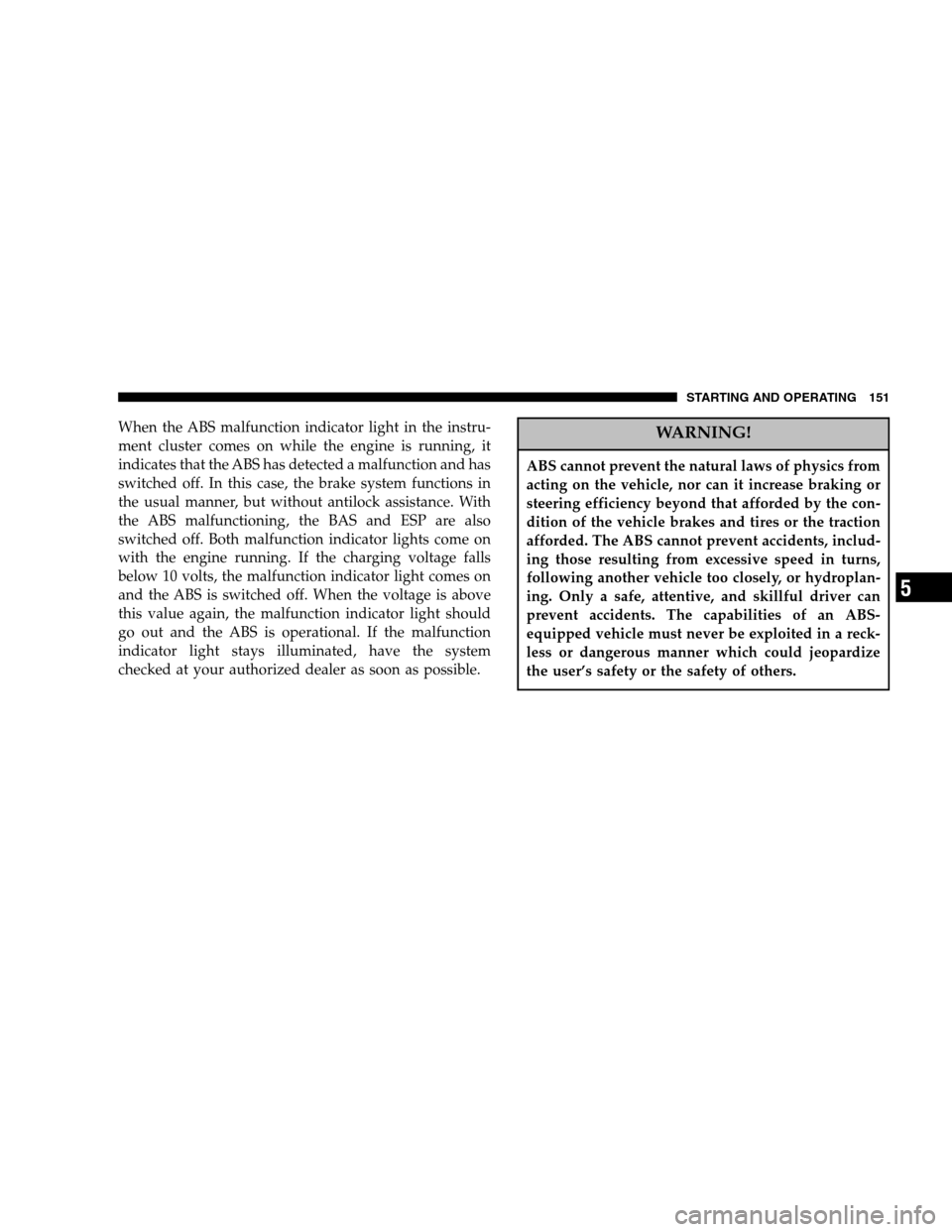2005 CHRYSLER CROSSFIRE warning lights
[x] Cancel search: warning lightsPage 71 of 288

To prevent possible damage, close the hood by dropping
it from approximately 12 inches (30 cm).
WARNING!
If the hood is not fully latched, it could fly up when
the vehicle is moving, and block your forward vi-
sion. You could have a collision. Be sure all hood
latches are fully latched before driving.
INTERIOR LIGHTS
A two-position mode selector switch controls the interior
lights located in the overhead console.
The AUTO mode turns the lights on when a door is open
or ajar, or when locking or unlocking the vehicle. AUTO
mode also has a “fade to off” feature. When the doors are
closed or locked, they gradually “fade” off.
The OFF position turns off the interior lights feature.
UNDERSTANDING THE FEATURES OF YOUR VEHICLE 71
3
Page 73 of 288

EXTERIOR LIGHTS
Headlights and Parking Lights
When the headlight switch is turned clockwise from OFF
to the first position, the parking lights, taillights, side
marker lights, license plate lights and instrument panel
lights are all illuminated.
The headlights turn on when the switch is turned to the
second position.
Lights-On Reminder
If the headlights or parking lights are left on after the
ignition is turned off, a warning will sound if the driver’s
door is opened.
Daytime Running Lights (Where Applicable)
VEHICLES WITH AUTOMATIC TRANSMISSION
The low beam headlights, parking lights, side marker
lights, taillights and license plate lights are automatically
switched on whenever the vehicle is started and the
transmission gear selector is in a driving position.
VEHICLES WITH MANUAL TRANSMISSION
The low beam headlights, parking lights, side marker
lights, taillights, and license plate lights are automatically
switched on whenever the vehicle is started and the
parking brake is released.
For nighttime driving, the exterior lights switch should
be in the low beam position to permit activation of the
high beam headlights.
UNDERSTANDING THE FEATURES OF YOUR VEHICLE 73
3
Page 103 of 288

The warning light should be checked frequently to assure
that it is operating properly. This can be done by turning
the ignition switch to START. The light should come on.
If the red brake light does not come on when the ignition
is turned to the ON/RUN position, have the brake light
repaired promptly.
WARNING!
Driving a vehicle with the brake light on is danger-
ous. Part of the brake system may have failed. It will
take longer to stop the vehicle. You could have an
accident. Have the vehicle checked immediately.
NOTE:This light shows only that the parking brake is
on. It does not show the degree of brake application.
The brake warning light will come on if the ABS light is
not functioning and there is an ABS system malfunction.
11. Light Outage Indicator
With the key in the ignition switch turned to
the ON/RUN position, an indicator light
comes on. It should go out when the engine
is running. If the indicator light does not go
out after starting the engine, or if it comes on while
driving, it indicates a failure in the parking light,
taillight, stoplight, or low beam headlight.
The indicator light will come on when the exterior light
fails. If a brake light fails, the light outage indicator will
come on when applying the brake and stays on until the
engine is turned off.
NOTE:If additional lighting equipment is installed
(e.g., auxiliary headlights, etc.) be certain to connect into
the fuse before the failure indicator monitoring unit in
order to avoid damaging the system.
12. Antilock Warning Indicator Light
The ABS warning indicator light comes on
with the key in the ignition switch turned to
the ON/RUN position, and should go out
with the engine running.
UNDERSTANDING YOUR INSTRUMENT PANEL 103
4
Page 146 of 288

With the ABS malfunctioning, the BAS and ESP will be
disabled. In this condition, both malfunction indicator
lights come on while the engine is running. If the
malfunction indicator light stays illuminated, have the
BAS and ESP checked at your authorized dealer as soon
as possible.
Electronic Stability Program (ESP)
The ESP enhances directional control and reduces wheel-
spin under various driving conditions. When ESP is
active, engine torque is limited and the ESP warning light
starts to flash.In winter operation, the effectiveness of the ESP can be
enhanced by equipping the vehicle with DaimlerChrysler
recommended mud and snow (M+S) rated radial-ply
tires and/or snow chains.
WARNING!
ESP cannot prevent the natural laws of physics from
acting on the vehicle, nor can it increase the traction
afforded. The ESP cannot prevent accidents, includ-
ing those resulting from excessive speed in turns, or
hydroplaning. Only a safe, attentive, and skillful
driver can prevent accidents. The capabilities of an
ESP equipped vehicle must never be exploited in a
reckless or dangerous manner which could jeopar-
dize the user’s safety or the safety of others.
The ESP warning light starts to flash at any vehicle speed
as soon as the tires lose traction and the wheels begin to
spin.
146 STARTING AND OPERATING
Page 151 of 288

When the ABS malfunction indicator light in the instru-
ment cluster comes on while the engine is running, it
indicates that the ABS has detected a malfunction and has
switched off. In this case, the brake system functions in
the usual manner, but without antilock assistance. With
the ABS malfunctioning, the BAS and ESP are also
switched off. Both malfunction indicator lights come on
with the engine running. If the charging voltage falls
below 10 volts, the malfunction indicator light comes on
and the ABS is switched off. When the voltage is above
this value again, the malfunction indicator light should
go out and the ABS is operational. If the malfunction
indicator light stays illuminated, have the system
checked at your authorized dealer as soon as possible.WARNING!
ABS cannot prevent the natural laws of physics from
acting on the vehicle, nor can it increase braking or
steering efficiency beyond that afforded by the con-
dition of the vehicle brakes and tires or the traction
afforded. The ABS cannot prevent accidents, includ-
ing those resulting from excessive speed in turns,
following another vehicle too closely, or hydroplan-
ing. Only a safe, attentive, and skillful driver can
prevent accidents. The capabilities of an ABS-
equipped vehicle must never be exploited in a reck-
less or dangerous manner which could jeopardize
the user’s safety or the safety of others.
STARTING AND OPERATING 151
5
Page 225 of 288

ammonia based cleaners to clean your leather upholstery.
Application of a leather conditioner is not required to
maintain the original condition.
CAUTION!
The use of vinyl, leather or plastic protectants may
cause excessive gloss and/or discoloration of interior
trim parts.
WARNING!
Do not use volatile solvents for cleaning purposes.
Many are potentially flammable, and if used in
closed areas they may cause respiratory harm.
Cleaning Headlights
Your vehicle has plastic headlights that are lighter and
less susceptible to stone breakage than glass headlights.
Plastic is not as scratch resistant as glass and therefore
different lens cleaning procedures must be followed.To minimize the possibility of scratching the lenses and
reducing light output, avoid wiping with a dry cloth. To
remove road dirt, wash with a mild soap solution fol-
lowed by rinsing.
Do not use abrasive cleaning components, solvents, steel
wool or other aggressive material to clean the lenses.
Glass Surfaces
All glass surfaces should be cleaned on a regular basis
with any commercial household-type glass cleaner.
Never use an abrasive-type cleaner. Use caution when
cleaning inside rear windows equipped with electric
defrosters. Do not use scrapers or other sharp instru-
ments which may scratch the elements.
Instrument Panel Cover
The instrument panel cover has a low glare surface which
minimizes reflections in the windshield. Do not use
protectants or other products which may cause undesir-
able reflections. Use soap and warm water to restore the
low glare surface.
MAINTAINING YOUR VEHICLE 225
7
Page 235 of 288

REPLACEMENT BULBS
Interior Light Bulbs
For lighted switches and interior lights, see your autho-
rized dealer for servicing requirements.
Exterior Light Bulbs
Bulb Bulb No.
Headlight - High and Low Beam......12V55W H7U
Front Turn Signal.......................Y21W
Front Parking/Standing Light.............. W5W
Front Side Marker Light.................. W5W
Rear Marker Light...................... W5W
Center High-Mounted Stop Light (CHMSL)..... LED
Front Fog Lights.....................HB455W
Rear Turn Signal Light...................Y21W
Rear Tail and Stop Light.................21/5W
Backup Light........................... 21W
License................................ 168
EXTERIOR LIGHT BULB SERVICE
Headlights
WARNING!
Halogen lamps contain pressurized gas. A bulb can
explode if you:
•touch or move it when hot,
•drop the bulb,
•scratch the bulb
Wear eye and hand protection.
NOTE:To prevent a possible electrical short circuit,
switch off light prior to replacing a bulb.
1. Push the tab down at the top end of the cover and
remove.
2. Disconnect the electrical connector.
MAINTAINING YOUR VEHICLE 235
7
Page 274 of 288

ABS (Anti-Lock Brake) System............. 103
Adding Engine Coolant (Antifreeze)......... 215
Adding Fuel.......................... 166
Aiming Headlights...................... 238
Air Cleaner, Engine..................... 205
Air Conditioning....................121,208
Air Conditioning Filter................... 256
Air Conditioning Refrigerant.............. 209
Air Conditioning System................. 208
Air Pressure, Tires...................153,154
Airbag................................ 28
Airbag Deployment...................... 32
Airbag Light........................31,109
Airbag Maintenance...................... 38
Airbag On/Off Switch..................36,40
Alignment and Balance.................. 163
Antenna.............................. 120
Antifreeze (Engine Coolant)............... 243
Anti-Lock Warning Light................. 103
Appearance Care....................... 222
Ashtrays and Lighter..................... 63
Automatic Door Locks.................... 13
Automatic Transmission...............135,220Fluid and Filter Changes................ 221
Fluid Level Check..................... 220
Fluid Type.......................... 220
Special Additives..................... 221
Autostick............................. 139
Ball Joints............................ 210
Battery............................104,207
Saving Feature........................ 72
Belts, Drive........................... 205
Belts, Seat............................. 21
Body Mechanism Lubrication.............. 211
Brake Assist System...................... 85
Brake, Parking......................... 142
Brake System.......................144,217
Anti-Lock........................... 144
Hoses.............................. 218
Master Cylinder...................... 219
Break-In Recommendations, New Vehicle . . . 46,152
Bulbs, Light........................... 235
Capacities, Fluid....................... 241
Capacity, Cargo Weight.................. 168
274 INDEX